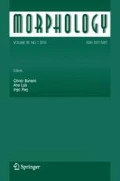Abstract
In the Chinese language, morphologically complex words have been attested since the remote past of the language, including both stem-modifying processes and agglutination of morphemes, mostly lexical and free in the classical language. However, in Chinese, grammaticalization typically entails no phonological alteration (Bisang, Studies in Language 20:519–597, 1996) and it is still a matter of debate whether compounding and derivation are two distinct phenomena in Modern Mandarin Chinese (see, among others, Pan et al, The research on word formation in Chinese, 2004). In this paper we shall tackle this issue in the framework of Construction Morphology (Booij, In: Dressler et al (eds) Morphology in demarcations, 2005; In: Montermini et al (eds) Selected proceedings of the 5th Décembrettes: morphology in Toulouse, 2007), also taking into account the diachronic perspective. Our proposal is that it is possible to analyse as instances of grammaticalized derivational formants the right-hand elements in word formation schemas such as [[X] x 性] n [[X] x xìng] n ‘the quality of X/connected with X’ (抽象性 chōuxiàngxìng “abstractness”), which undergo processes of semantic shift analogous to those of e.g. English -hood.
Similar content being viewed by others
References
Aikhenvald, S. (2007). Typological distinctions in word formation. In T. Shopen (Ed.), Language Typology and Syntactic Description, volume III: Grammatical categories and the lexicon (2n ed) (pp. 1–65). Cambridge: CUP.
Amha, A. (2001). The Maale language. Leiden: Research School of Asian, African, and Amerindian Studies, University of Leiden.
Amiot D. (2005) Between compounding and derivation—elements of word-formation corresponding to prepositions. In: Dressler W., Kastovsky D., Pfeiffer O.E., Rainer F. (eds) Morphology and its demarcations. John Benjamins, Amsterdam, Philadelphia, pp 183–195
Arcodia G.F. (2008) La derivazione lessicale in cinese mandarino. Franco Angeli, Milano
Bauer L. (1998) Is there a class of neoclassical compounds, and if so is it productive?. Linguistics 36: 403–422
Bauer, L. (2001). Compounding. In M. Haspelmath, E. König, W. Oesterreicher, & W. Raible (Eds.), Language typology and language universals (pp. 695–707). Berlin, New York: Mouton de Gruyter.
Bauer, L. (2002). What can you do with derivational morphology. In S. Bendjaballah, W. U. Dressler, O. E. Pfeiffer, & M. D. Voeikova (Eds.), Morphology 2000. Selected papers from the 9th morphology meeting (pp. 37–48). Amsterdam, Philadelphia: John Benjamins.
Bauer L. (2005) The borderline between derivation and compounding. In: Dressler W., Kastovsky D., Pfeiffer O.E., Rainer F. (eds) Morphology and its demarcations. John Benjamins, Amsterdam, Philadelphia, pp 97–108
Bauer L. (2006). Compound. In K. Brown (Ed.), Encyclopedia of language and linguistics (II volume, pp. 719–726). Oxford: Elsevier.
Beard, R. (1998). Derivation. In A. Spencer, & A. M. Zwicky (Eds.), Handbook of morphology (pp. 44–65). Oxford: Blackwell.
Bisang W. (1996) Areal typology and grammaticalization: Processes of grammaticalization based on nouns and verbs in East and mainland South East Asian languages. Studies in Language 20: 519–597
Blank, A. (2001). Pathways of lexicalization. In M. Haspelmath, E. König, W. Oesterreicher, & W. Raible (Eds.), Language typology and language universals (pp. 1596–1608). Berlin, New York: Mouton de Gruyter.
Booij, G. (2005). Compounding and derivation—evidence for Construction Morphology. In W. Dressler, D. Kastovsky, O. E. Pfeiffer, & F. Rainer (Eds.), Morphology and its demarcations (pp.109–132). Amsterdam, Philadelphia: John Benjamins.
Booij, G. (2007). Construction morphology and the lexicon. In F. Montermini, G. Boyé, & N. Hathout (Eds.), Selected proceedings of the 5th Décembrettes: Morphology in Toulouse (pp. 34–44). Somerville, (MA): Cascadilla Proceedings Project.
Booij, G. (2009). Compounding and construction morphology. In R. Lieber, & P. Štekauer (Eds.), The Oxford handbook of compounding (pp. 201–216). Oxford: Oxford University Press.
Booij G. (2010) Compound construction: Schemas or analogy?. In: Scalise S., Vogel I. (eds) Crossdisciplinary issues in compounding. John Benjamins, Amsterdam, Philadelphia, pp 93–108
Brinton L.J., Traugott E. (2005) Lexicalization and language change. Cambridge University Press, Cambridge
Bybee J., Perkins R., Pagliuca B. (1994) The evolution of grammar. Tense, aspect and modality in the languages of the world. University of Chicago Press, Chicago
Campbell, L. (2001). What’s wrong with grammaticalization. In L. Campbell (Ed.), Grammaticalization: A critical assessment. Language Sciences (special issue), 23, 113–161.
Carstairs-McCarthy A. (1992) Current morphology. Routledge, London and New York
CCD (2002). 现 代 汉 语 词 典. The contemporary Chinese dictionary. Beijing, Foreign Language Teaching and Research Press.
Ceccagno A., Basciano B. (2007) Compound headedness in Chinese: An analysis of neologisms. Morphology 17: 207–231
Chen, R. (1986). 谈词缀 “性” (On the affix “-xìng”). Xinjiang Shifan Daxue Xuebao, 2, 87–90.
Cheng, L. (2004). 语訁接触, 类推与形态化 (Language contact, analogy and morphologization). Waiyu yu waiyu jiaoxue, 4. 53–56
Dong, Z. (2003). 关于几个新兴“词缀”的探讨 [A study on some newly coined affixes]. Tangshan Shifan Xueyuan Xuebao, 1, 8–10.
Dong, X. (2004).汉 语 的 词 库 与 词 法 [Chinese lexicon andmorphology]. Beijing: PekingUniversity Press.
Fabb N. (1998) Compounding. In: Spencer A., Zwicky A.M. (eds) Handbook of morphology. Blackwell, Oxford, pp 66–83
Fan, L. (2002). 从“吧”谈汉语词的词缀化倾向 [A discussion on ba and the tendency of Chinese words to turn into affixes]. Xinjiang daxue Xuebao, 30, 136–137.
GHYDCD (2000). 古汉语大词典 [The grand dictionary of ancient Chinese]. Shanghai: Shanghai Cishu Chubanshe.
Goldberg A. (1995) Constructions: A construction grammar approach to argument structure. University of Chicago Press, Chicago
Grandi, N. (2006). Considerazioni sulla definizione e la classificazione dei composti. Annali dell’Universitá di Ferrara (Sezione di Lettere), 1, 31–52.
Hagège, C. (2005). World classes in isolating languages. In A. D. Cruse, et al. (Eds.), Lexikologie/ Lexicology (pp. 976–980). Berlin, New York: Mouton de Gruyter.
Haspelmath M. (2002) Understanding morphology. Oxford University Press, Oxford
Heine B., Kuteva T. (2002) World lexicon of grammaticalization. Cambridge University Press, Cambridge
Heine B., Claudi U., Hünnemeyer F. (1991) Grammaticalization: A conceptual framework. University of Chicago Press, Chicago
Himmelmann, N. P. (2004). Lexicalization and grammaticalization: Opposite or orthogonal? In W. Bisang, N. P. Himmelmann, & B. Wiemer (Eds.),What makes grammaticalization? A look from its fringes and its components (pp. 21–42). Berlin and New York: Mouton de Gruyter.
Hopper P., Traugott E.C. (2003) Grammaticalization (2nd ed). Cambridge University Press, Cambridge
HYDCD (1991). 汉语大词典 [The Grand Dictionary of Chinese]. Shanghai: Hanyu Dacidian Chubanshe.
Jackendoff R.S. (2002) Foundations of language. Oxford University Press, Oxford
Jurafsky D. (1996) Universals tendencies in the semantics of the diminutive. Language 72: 533–578
Kuryłowicz J. (1936) Dérivation lexicale et dérivation syntactique. Bulletin de la Société Linguistique de Paris 37: 79–92
Lehmann, C. (1982/1995). Thoughts on grammaticalization. München: Lincom Europa.
Lehmann C. (1989) Grammatikalisierung und Lexikalisierung. Zeitschrift für Phonetik, Sprachwissenschaft und Kommunikationsforschung 42: 11–19
Lieber, R. (2003). Compound interpretation: Lexical semantics, not syntax. In G. Booij, J. DeCesaris, A. Ralli, & S. Scalise (Eds.), Topics in morphology: Selected papers from the third Mediterranean Morphology Meeting (pp. 241–253). Barcelona: IULA.
Lin H. (2001) A grammar of Mandarin Chinese. Lincom Europa, München
Lü, S. (1941). 中国文法要略 [An outline of Chinese grammar]. Shanghai: The Commercial Press.
Luo, J. (2004). “X性” 词族探微 [On the “X xìng” [On the “X xìng” word family]. Jiangtan Shifan Xueyuan Xuebao, 3, 91–94.
Ma, Q. (1995). 现代汉语词缀的性质, 范围和分类 [Nature, domain and classification of affixes in Modern Chinese]. Zhongguo Yuyanxuebao, 6, 101–137.
Magni, E. (2008). Conservazione e innovazione nella morfologia derivazionale dell’italiano: analisi sincronica e diacronica del suffisso -aio. In E. Cresti (Ed.), Prospettive nello studio del lessico italiano (pp. 497–506). Firenze: Firenze University Press.
Michaelis L.A., Lambrecht K. (1996) Toward a construction-based theory of language function: The case of nominal extraposition. Language 72: 215–247
Naumann, B., & Vogel, P.M. (2000) Derivation. In G. Booij, et al. (Eds.), Morphologie—Morphology (pp. 929–943). Berlin, New York: Mouton de Gruyter.
Olsen, S. (2000). Composition. In G. Booij, J. Mugdan, & C. Lehmann (Eds.), Morphologie – Morphology (pp. 897–916). Berlin, New York: Mouton de Gruyter.
Packard J.L. (2000) The morphology of Chinese. A linguistic and cognitive approach. Cambridge University Press, Cambridge
Pan, W., Ye, B., & Han, Y. (2004) 汉语的构词法研究 [The research on word formation in Chinese]. Shanghai: Huadong Shifan Daxue Chubanshe.
Ramat P. (1992) Thoughts on degrammaticalization. Linguistics 30: 549–560
Renouf, A., & Baayen, H. (1998). Aviating among the hapax legomena: Morphological grammaticalization in current British newspaper English. In A. Renouf (Ed.), Explorations in corpus linguistics (pp. 181–189). Amsterdam, Atlanta: Rodopi.
Ricca D. (2005) Appunti per una tipologia degli universali morfologici. In: Grandi N. (eds) Morfologia e dintorni. Franco Angeli, Milano, pp 28–46
Scalise, S., Bisetto, A., & Guevara, E. (2005). Selection in compounding and derivation. In W. Dressler, D. Kastovsky, O. E. Pfeiffer, & F. Rainer (Eds.), Morphology and its demarcations (pp. 133–150). Amsterdam, Philadelphia: John Benjamins.
Shi Y. (2002) The estabilishment of Modern Chinese grammar. The formation of the resultative construction and its effects,. John Benjamins, Amsterdam, Philadelphia
SOED (1993). The new shorter Oxford English dictionary. Oxford: Clarendon Press.
Sun, Y. (2000). 现代汉语词缀问题探讨 [A study on some problems related to Modern Chinese affixes]. Hebei Shifan Daxue Xuebao, 23, 55–58.
Tekavčić, P. (1980). Grammatica storica dell’Italiano (Vol. III. Lessico). Bologna: Il Mulino.
Ten Hacken, P. (2000). Derivation and compounding. In G. Booij, J. Mugdan, & C. Lehmann (Eds.), Morphologie-Morphology (pp. 349–360). Berlin, New York: Mouton de Gruyter.
VD (2005). Van Dale Groot Woordenboek van de nederlandse taal. Utrecht, Antwerpen: Van Dale Lexicografie.
Wu, Y. (2000). 吧 - 新产生的类后缀 [Ba—a newly coined suffixoid]. Jiangxi Shifan Daxue Xuebao, 4, 73–77.
XH (2003). 新华新词语词典 [The Xinhua Dictionary of new words]. Beijing: The Commercial Press.
Xing J.Z. (2003) Grammaticalization of verbs in Mandarin Chinese. Lincom Europa, München
Yip P. (2000) The Chinese Lexicon A comprehensive survey. Routledge, London, New York
Zhou X., Marslen-Wilson W. (1994) Words, morphemes and syllables in the Chinese mental lexicon. Language and Cognitive Processes 9: 393–422
Author information
Authors and Affiliations
Corresponding author
Rights and permissions
About this article
Cite this article
Arcodia, G.F. A Construction Morphology account of derivation in Mandarin Chinese. Morphology 21, 89–130 (2011). https://doi.org/10.1007/s11525-010-9173-2
Received:
Accepted:
Published:
Issue Date:
DOI: https://doi.org/10.1007/s11525-010-9173-2




